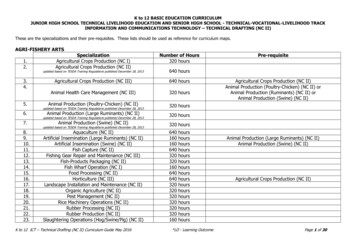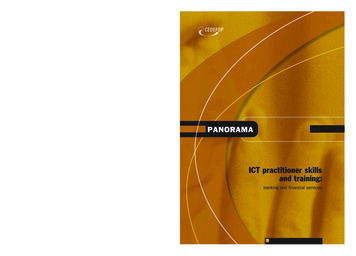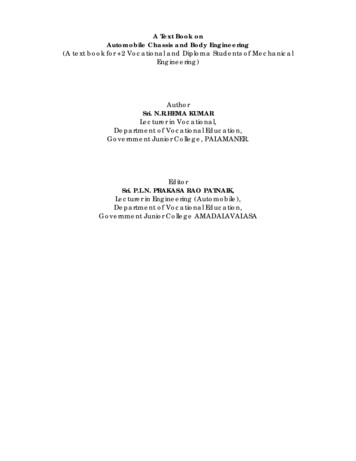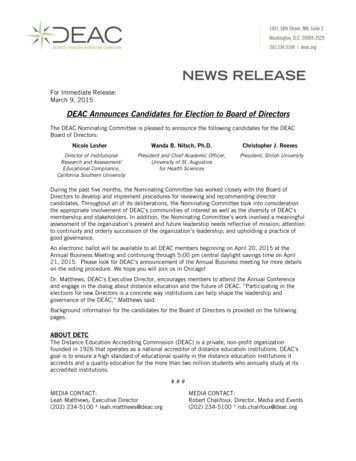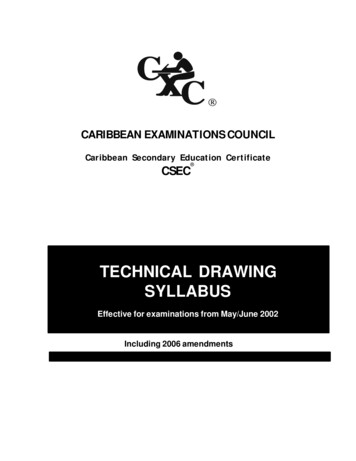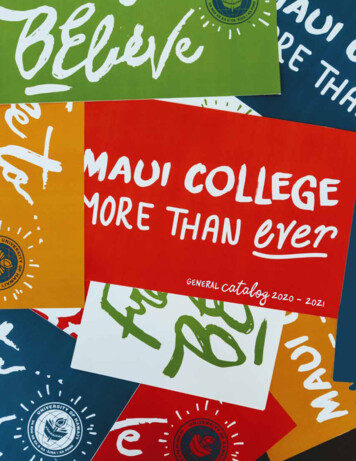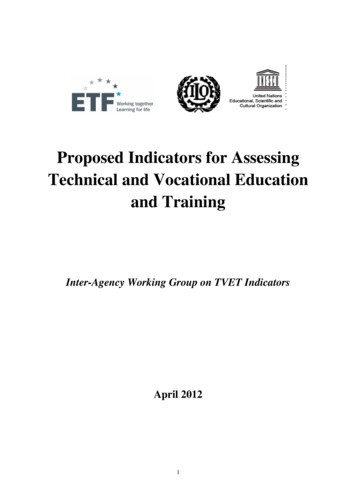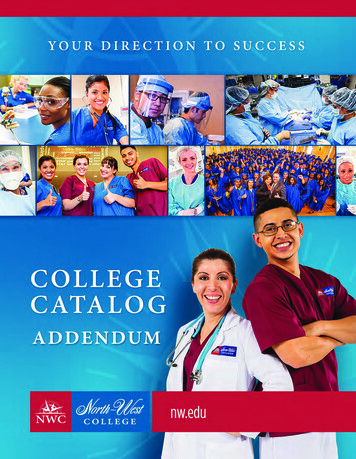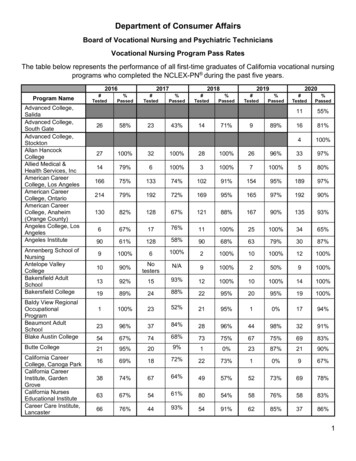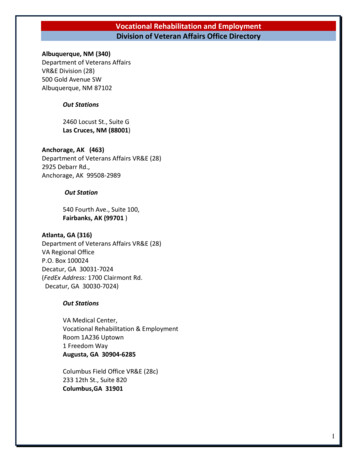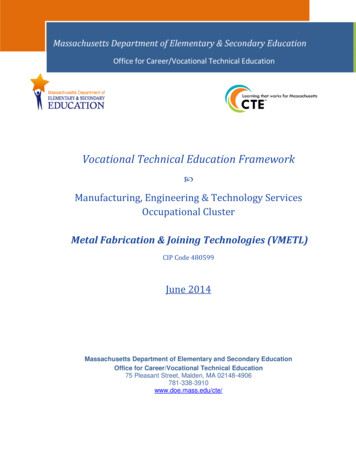
Transcription
Massachusetts Department of Elementary & Secondary EducationOffice for Career/Vocational Technical EducationVocational Technical Education Framework Manufacturing, Engineering & Technology ServicesOccupational ClusterMetal Fabrication & Joining Technologies (VMETL)CIP Code 480599June 2014Massachusetts Department of Elementary and Secondary EducationOffice for Career/Vocational Technical Education75 Pleasant Street, Malden, MA 02148-4906781-338-3910www.doe.mass.edu/cte/
This document was prepared by theMassachusetts Department of Elementary and Secondary EducationMitchell D. Chester, Ed.D.CommissionerBoard of Elementary and Secondary Education MembersMs. Maura Banta, Chair, MelroseMs. Harneen Chernow, Vice Chair, Jamaica PlainMr. Daniel Brogan, Chair, Student Advisory Council, DennisDr. Vanessa Calderón-Rosado, MiltonMs. Karen Daniels, MiltonMs. Ruth Kaplan, BrooklineDr. Matthew Malone, Secretary of Education, RoslindaleMr. James O’S., Morton, SpringfieldDr. Pendred E. Noyce, WestonMr. David Roach, SuttonMitchell D. Chester, Ed.D., Commissioner and Secretary to the BoardThe Massachusetts Department of Elementary and Secondary Education, an affirmative actionemployer, is committed to ensuring that all of its programs and facilities are accessible to all membersof the public.We do not discriminate on the basis of age, color, disability, national origin, race, religion, sex, genderidentity, or sexual orientation.Inquiries regarding the Department’s compliance with Title IX and other civil rights laws may bedirected to theHuman Resources Director, 75 Pleasant St., Malden, MA 02148-4906. Phone: 781-338-6105. 2014 Massachusetts Department of Elementary and Secondary EducationPermission is hereby granted to copy any or all parts of this document for non-commercial educationalpurposes. Please credit the “Massachusetts Department of Elementary and Secondary Education.”This document printed on recycled paperMassachusetts Department of Elementary and Secondary Education75 Pleasant Street, Malden, MA 02148-4906Phone 781-338-3000 TTY: N.E.T. Relay 800-439-2370www.doe.mass.edu
Table of ContentsAcknowledgements. 1Commissioner’s Letter . 4Introduction . 5Manufacturing, Engineering & Technology Services Occupational Cluster . 14Metal Fabrication & Joining Technologies Framework (VMETL) . 14Strand 1: Safety and Health Knowledge and Skills. 14Selected Websites . 16Strand 2: Technical Knowledge and Skills . 17Strand 3: Embedded Academics . 22Strand 4: Employability and Career Readiness . 23Selected Websites . 26Strand 5: Management and Entrepreneurship Knowledge and Skills . 28Selected Websites . 30Glossary. 30Strand 6: Technology Literacy Knowledge and Skills . 32Appendices. 34Embedded Academic Crosswalks . 35Embedded English Language Arts and Literacy . 35Embedded Mathematics . 36Embedded Science and Technology/Engineering . 39Earth and Space Science . 39Life Science (Biology). 39Physical Science (Chemistry) . 39Physical Science (Physics) . 39Technology/Engineering . 40DESE Statewide Articulation Agreements. 42Industry Recognized Credentials (Licenses and Certifications/Specialty Programs) . 43Other . 44Reference Materials . 44Related National, Regional, and State Professional Organizations . 44Student Organizations. 44
AcknowledgementsThe Massachusetts Department of Elementary and Secondary Education, Office for Career/ Vocational TechnicalEducation, launched the Vocational Technical Education Framework Revision Project in April 2012. This Frameworkis the result of that effort and of the contributions of many educators across the state. The Department of Elementaryand Secondary Education wishes to thank all of the Massachusetts groups that contributed to the development ofthese standards and all the individual teachers, administrators, and private sector advisory committee members whoprovided valuable employer validation of the standards for the Metal Fabrication & Joining Technologies Frameworkof the Manufacturing, Engineering & Technology Services Occupational Cluster.Contributors to the 2012 Metal Fabrication & Joining Technologies Framework (VMETL) Strands 2, 3 and 6:Project Administrator:Russell Mangsen, Director of Technical Programs, Assabet Valley Regional Technical High SchoolJeff Koopman, Supervisor of Placement and Programs, Assabet Valley Regional Technical High SchoolFramework Team Leader:Neil B. Mansfield, Lead Teacher, Assabet Valley Regional Technical High SchoolTechnical Teachers:John Kline, McCann Technical High School; Paul R. Nogueira, Diman Regional Technical High School; Arnie Thetonia, BristolPlymouth Technical High School; Heather Gray, Montachusett Regional High School; Clifford B. Goyette, Blackstone ValleyTechnical High SchoolAcademic Teachers:Nancy Caparelli, English Teacher, Assabet Valley Regional Technical High School; Sarah McCann, Mathematics Teacher,Assabet Regional Technical High School; Patrick Tobin, Science Teacher, Assabet Regional Technical High SchoolProgram Advisory Members:Joseph P. Janeiro, Holmed CorporationRobert C. Cook, Owner, New Bedford Welding Supply, Inc.Glenn Andrews, Sheet Metal Foreman, Adams Plumbing and HeatingScott D. Houle, Manufacturing Plant Manger and Welding Engineer, Steel-Fab, Inc.Jim Lambert, Bonner Sheet MetalBob Caras, Owner, Ledgerock WeldingAdministrative Assistance: Lynn McKiernan, Assabet Valley Regional Technical High SchoolCVTE Frameworks Project Advisory CommitteeRoger Bourgeois, Superintendent/DirectorPeter Dewar, Director of Professional DevelopmentEssex Agricultural and Technical High SchoolMassachusetts Association of Vocational AdministratorsChristine Shaw, Executive DirectorJohn McDonagh, Grants CoordinatorNortheast Regional Readiness CenterSoutheastern Regional Vocational Technical High SchoolMassachusetts Department of Elementary and Secondary EducationPatricia Gregson, Associate CommissionerVocational, Workforce and College Readiness ProgramsOffice for Career/Vocational and Technical Education – Framework Revision Strands 2, 3 and 6Lisa Sandler, Acting State Director of Career/Vocational Technical EducationMaura RussellRamona FosterKaren DeCosterLisa WeinsteinMargie RobertsJanice CrockerDr. Frank LlamasConsultantsManufacturing, Engineering & Technology Services Occupational ClusterMassachusetts Vocational Technical Education FrameworkMaura McMahonMetal Fabrication & Joining Technologies Framework1
Contributors to the 2014 Metal Fabrication & Joining Technologies Framework (VMETL)Strands 1, 4 and 5:Project AdministratorThomas Hickey, SuperintendentSouth Shore Vocational Technical High SchoolProject ManagersRebecca Buck, Northern Berkshire Vocational Regional School DistrictKristin Steiner, Northern Berkshire Vocational Regional School DistrictKathy ConoleMAVA ConsultantsDeborah DePaoloJohn McDonaghMassachusetts Department of Elementary and Secondary EducationPatricia Gregson, Associate CommissionerVocational, Workforce and College Readiness ProgramsOffice for Career/Vocational and Technical Education – Framework Revision Strands 1, 4 and 5Lisa Sandler, Massachusetts Methods of Administration CoordinatorGary Gomes, Accountability & Monitoring SupervisorMarnie Jain, Education SpecialistFramework Strand 1 Leader:Michael Nixon, MassBay Community CollegeTeam Members:Patricia Allen, Greater New Bedford Regional Technical High SchoolCheryl Bomal, Greater Lowell Technical High SchoolDeborah Brightman, Greater New Bedford Regional Technical High SchoolMartin Dooley, Lower Pioneer Valley Career and Technical Education CenterDarla Hartung, Taunton High SchoolRhonda Moran, Lower Pioneer Valley Career and Technical Education CenterJohn Morash, Plymouth South High SchoolJohn Taylor, Greater Lowell Technical High SchoolResource Experts:Anne Gilligan, DESE-Learning Support Service, Safe and Healthy Schools CoordinatorDavid Edmonds, DESE-CVTE, Education SpecialistLisa Sandler, DESE-CVTE, Massachusetts Methods of Administration CoordinatorFramework Strand 4 Leader:Marcia Kessler, Old Colony Regional Vocational Technical High SchoolTeam Members:Erin Carerra, Taunton High SchoolGillian Granger, Blackstone Valley Regional Vocational Technical High SchoolManufacturing, Engineering & Technology Services Occupational ClusterMassachusetts Vocational Technical Education FrameworkMetal Fabrication & Joining Technologies Framework2
Carol Hartnett, Blue Hills Regional Technical High SchoolChristina Melvin, Worcester Technical High SchoolCecilia Smith, Greater Lawrence Technical SchoolEJ Smith, Blackstone Valley Regional Vocational Technical High SchoolMichael Viggiano, Madison Park High SchoolResource Experts:Gary Gomes, DESE-CVTE, Accountability and MonitoringElizabeth Hennessy, Blackstone Valley Regional Vocational Technical High School, Dir. of CounselingMarnie Jain, DESE-CVTE,Judith McKinstry, Business Professionals of America DirectorLisa Sandler, DESE – CVTE, Massachusetts Methods of Administration CoordinatorShailah Stewart, DESE - College & Career Readiness, Connecting Activities CoordinatorKaren Ward, SkillsUSA DirectorFramework Strand 5 Leader:Margaret Ellis, JP Keefe Technical High SchoolTeam Members:Lori Alie, Blackstone Valley Regional Vocational Technical High SchoolLori Carr, Taunton High SchoolBarbara-jean Chauvin, Norfolk County Agricultural High SchoolCheryl Hackenson, Tantasqua Regional High SchoolClifford Keirstead, Whittier Regional Technical High SchoolLynn McKiernan, Assabet Valley Regional Technical High SchoolJohn Oldham, Old Colony Regional Vocational Technical High SchoolArlene Thompson, Worcester Technical High SchoolResource Experts:Jennifer Green, Network For Teaching Entrepreneurship Executive DirectorDonna McFadden, MA DECA DirectorLisa Sandler, DESE –CVTE, Massachusetts Methods of Administration CoordinatorManufacturing, Engineering & Technology Services Occupational ClusterMassachusetts Vocational Technical Education FrameworkMetal Fabrication & Joining Technologies Framework3
Commissioner’s LetterMassachusetts Department ofElementary and Secondary Education75 Pleasant Street, Malden, Massachusetts 02148-4906Telephone: (781) 338-3000TTY: N.E.T. Relay 1-800-439-2370Mitchell D. Chester, Ed.D.CommissionerJuly 2014Dear Colleagues,I am pleased to present to you the Massachusetts Vocational Technical Education Frameworks,adopted by the Department of Elementary and Secondary Education in June 2014. Theseframeworks, one for each of the 44 vocational technical programs, include standards in multiplestrands representing all aspects of the industries that students in the vocational technicaleducation program are preparing to enter.The frameworks also include a crosswalk between the technical standards and relevant standardsin Massachusetts Curriculum Frameworks to support effective integration of academic andtechnical content.The comments and suggestions received during revision of the 2007 Massachusetts VocationalTechnical Education Frameworks have strengthened these frameworks. We will continue towork with schools and districts to implement the 2014 Massachusetts Vocational TechnicalEducation Frameworks over the next several years, and we encourage your comments.I want to thank everyone who worked with us to create challenging learning standards forMassachusetts students. I am proud of the work that has been accomplished.Sincerely,Mitchell D. Chester, Ed.D.Commissioner of Elementary and Secondary EducationManufacturing, Engineering & Technology Services Occupational ClusterMassachusetts Vocational Technical Education FrameworkMetal Fabrication & Joining Technologies Framework4
IntroductionOverview & Organization and Key ChangesOverviewThe Massachusetts Department of Elementary and Secondary Education understands the necessity ofmaintaining current Vocational Technical Education Frameworks which ensure career/vocational technicaleducation students across the Commonwealth are taught the most rigorous standards aligned to the needsof business and industry.With the advent of the Massachusetts Teaching & Learning System the Office for Career/VocationalTechnical Education (CVTE) recognized the significance of including career/vocational technical educationin the system and developed a comprehensive plan for including vocational technical education. The planwas designed in a Two Phase Process. Phase One included the revision of strands two, three, and six, of allof the Vocational Technical Education Frameworks. Phase Two consisted of three major components(projects) all equally crucial;1. The revision of Strands One, Four, and Five to complete the revision of all six strands of theVocational Technical Education Frameworks;2. Statewide Professional Development on all revised strands, with training on strands two, three, andsix delivered fall 2013, and training on strands one, four, and five delivered spring 2014;3. The creation and development of additional Model Curriculum Unit (MCU) Teams.The Office for Career/Vocational Technical Education Framework Team, with support from consultants,began Phase One in the 2012-2013 school year, to revise three of the six strands contained in all of theVocational Technical Education (VTE) Frameworks. The state was organized into “CollaborativePartnerships” comprised of teams of project administrators, highly qualified subject matter educators, andbusiness and industry partners, whose task was to revise Strand Two – Technical, Strand Three –Embedded Academics, and Strand Six – Technology Literacy. Each team met with a vocational advisorycommittee which included business and industry representatives and postsecondary educationprofessionals, whose mission was to review and revise the team’s draft document during the revisionaryprocess. Once strand two was revised, academic teachers (typically one English Language Arts teacher, oneMathematics teacher, and one Science teacher) worked with the technical subject matter teachers todevelop a crosswalk between academic curricula standards and the technical standards, and providedexamples of embedded academic content.The Office for Career/Vocational Technical Education solicited statewide input from technical andacademic teachers and administrators at the annual Massachusetts Association of VocationalAdministrators (MAVA)/Massachusetts Vocational Association (MVA) - Connecting for Success Conference.Each framework team met with their content colleagues and reviewed the draft revisions and obtainedvaluable feedback. Additionally, all drafts were reviewed and revised by the Massachusetts VocationalTechnical Teacher Testing Program, to ensure appropriate measurable language.Manufacturing, Engineering & Technology Services Occupational ClusterMassachusetts Vocational Technical Education FrameworkMetal Fabrication & Joining Technologies Framework5
Project consultants designed a new template to ensure all framework teams entered new standards andadditional resources in a consistent manner. The framework teams created an “Appendix” listing potentialindustry recognized credentials attainable by secondary students; lists of professional, student, andrelevant government organizations; and useful resources and websites. * It is important to note thatalthough most Framework Teams provided information for the “Appendix”, not all teams did. Therefore, subheadings within the “Appendix” without information have been deleted. Disclaimer: Reference in theAppendices Section to any specific commercial products, processes, or services, or the use of any trade, firm orcorporation name is for the information and convenience of the public, and does not constitute endorsementor recommendation by the Massachusetts Department of Elementary and Secondary Education.The Office for Career/Vocational Technical Education facilitated a comprehensive vetting processthroughout the Commonwealth. During the fall of 2012 districts throughout Massachusetts solicitedfeedback from each Vocational Program’s Advisory Committee members at the Fall Board meetings.Additionally, the Office for Career/Vocational Technical Education met with various licensing boards at theMassachusetts Division of Professional Licensure and provided the applicable draft framework to eachboard for review. All framework drafts were posted on the CVTE website for public comment. Commentsand suggested revisions received were shared with each framework team for response and edits, asappropriate.The Phase I Process was completed on an accelerated timetable and resulted in all Vocational TechnicalEducation Frameworks; Stand Two and Strand Six, revised with current, rigorous, relevant standards.Strand Three has been redesigned into a crosswalk which directly correlates academic and technicalstandards. An appendix of useful material for technical teachers recommended by their peers was added toeach framework.Phase II of the Framework Revision Process consisted of three major projects;1. The Strands One, Four & Five Project, to complete the revision of all six strands of the VocationalTechnical Education Frameworks;2. Statewide Professional Development on all revised strands, with training on strands two, three, andsix delivered fall 2013, and training on strands one, four, and five delivered spring 2014;3. The creation and development of additional Model Curriculum Unit (MCU) Teams.The Strands One, Four, & Five Project began in the fall of 2013 with the formation of a leadership team andthree work groups. Co-Managers led the leadership team comprised of three Strand Coordinators whofacilitated work teams and reviewed, researched, and revised these common strands. All skills specific tothe vocational technical program have been included into Strand Two Technical.The Strand One Team revised the safety knowledge and skills that all students need to acquire. The teamincluded relevant issues (i.e., bullying, climate), laws, regulations, guidelines and policies pertaining tosafety.The Strand Four Team revised the Employability Knowledge and Skills that all students need to acquire.Teams considered current research on career readiness, including the work of the College CareerReadiness Task Force convened by the Department, changes in workplace, technological changes thatimpact how people perform their work (i.e., communications methods), and included standards thatManufacturing, Engineering & Technology Services Occupational ClusterMassachusetts Vocational Technical Education FrameworkMetal Fabrication & Joining Technologies Framework6
emphasize the need for lifelong learning and adaptability given the multiple career changes over and anindividual’s working life. The team recommended this strand be renamed to: Career Readiness.The Strand Five Team revised the Management & Entrepreneurship Knowledge and Skills that all studentsneed to acquire. All business owners and employees must possess management and financial skills to beproductive members of society. Skills included financial knowledge and basic business management skills.All Strand One, Four and Five Project Teams worked collaboratively with staff from the Department ofElementary and Secondary Education and the Advisors of the Massachusetts Career and Technical StudentOrganizations to crosswalk standards to national Career & Technical Student Organizations Curricula, asapplicable.The Office for Career/Vocational Technical Education contracted the MAVA Consultant Team to workclosely with the office to complete all of the work accomplished during Phase II of the Project.A remarkable amount of work was accomplished through the efforts of hundreds of professionals whocollaborated and diligently supported this work. The Office for Career/Vocational Technical Education isgrateful for all the support received from the field, particularly all of the teachers (technical and academic),administrators, advisory committee members, business and industry representatives, the Division ofProfessional Licensure - boards, the Massachusetts Association of Vocational Administrators, the MAVAConsultants, and the Massachusetts Vocational Association, whose contributions were tremendous.Special thanks to all staff in the Office for Career/Vocational Technical Education and the CVTE FrameworkRevision Team who provided guidance and numerous contributions during Phase One of the project.Manufacturing, Engineering & Technology Services Occupational ClusterMassachusetts Vocational Technical Education FrameworkMetal Fabrication & Joining Technologies Framework7
Organization and Key ChangesThis section contains the following: Highlights of Changes to the Vocational Technical Education Frameworks; which includes asummary of changes made to each strand.Organization of the Frameworks – Strand Two illustrates structure of topic headings, standardsand objectives, and performance examples.Highlights of Changes to the Vocational Technical Education Frameworks:Strand One:Safety and Health Knowledge and Skills have been revised to contain the safety standards that are commonto all programs. The Strand One Team worked collaboratively with staff from the Department ofElementary and Secondary Education and the Advisors of the Career and Technical Student Organizations(CTSO) to crosswalk standards to national CTSO Curricula, as applicable. No objectives were deleted, only modified.Language and wording was clarified.Additions included a focus on maintaining a safe school and workplace in terms of creating apositive climate/environment.Student safety credential program has been revised.Safety attire has been revised.Emergency equipment and fire safety has been revised.Many new Performance Examples have been included.Within each strand, standards and objectives were grouped under Topic Headings, which aredisplayed in bold. Each standard is followed by a performance example. See the section belowtitled: “Organization of the Frameworks – Strand Two”. All strands were organized in that manner,with the exception of the former Strand Three.Strand Two:The Technical Standards Knowledge and Skills have been revised to reflect business and industry changessince the adoption of the 2007 Vocational Technical Education Frameworks (VTEF). There are additionalchanges to Strand Two below: The Technical Knowledge and Skills (Strand Two) section contains standards specific to theparticular vocational program; suffix “a” (as common to all programs) and suffix “c” (as commonwithin a cluster) have been removed.Each VTEF Strand Two begins with safety and health knowledge and skills specific to the particularvocational program.Within each strand, standards and objectives were grouped under Topic Headings, which aredisplayed in bold. Each standard is followed by a performance example. See the section belowtitled: “Organization of the Frameworks – Strand Two”. All strands were organized in that manner,with the exception of the former Strand Three.Manufacturing, Engineering & Technology Services Occupational ClusterMassachusetts Vocational Technical Education FrameworkMetal Fabrication & Joining Technologies Framework8
Strand Two of the Frameworks for Animal Science, Environmental Science and Technology, andHorticulture, begin with core standards required for all participants in the programs, followed by aseries of standards organized in concentrations. See the section below titled: “Organization of theFrameworks – Strand Two” for more information.An update to some of the vocational programs framework is the addition of advanced orsupplemental standards which are noted in Strand Two by an asterisk (*). These standards are notrequired, but are provided as suggestions that districts may choose to use to increase the depth of aparticular topic, or add additional topics, particularly for advanced students or for those seniors whodo not participate in cooperative education. See the section below titled: “Organization of theFrameworks – Strand Two” for more information.Strand Three:Since the purpose of Strand Three was to correlate academic content that was embedded in the knowledgeand skills necessary to perform certain technical skills, it was logical to highlight those connections througha crosswalk between the academic curriculum standards and the technical standards (Strand Two). Thecrosswalk directly correlates the English Language Arts (2011) and Mathematics (2011) Frameworks,incorporating the Common Core Standards and the Science and Technology/Engineering Frameworks. Thecrosswalk can be found in the appendix of each vocational framework. The crosswalk also includesperformance examples which illustrate integrated academic and technical content. Embedded Academics has been replaced with a crosswalk between the academic curriculumstandards and the technical knowledge and skills standards. The crosswalk is located in theAppendices.Strand Four:Employability (and Career Readiness) Knowledge and Skills focused on providing students with generalknowledge and skills to be college and career ready. The Strand Four Team worked collaboratively withstaff from the Department of Elementary and Secondary Education and the Advisors of the Career andTechnical Student Organizations to crosswalk standards to national CTSO Curricula, as applicable. Language and wording were clarified.Additions included a focus on providing students with skills for employability/career readiness.Modifications included Career Exploration & Navigation, Communication in the Workplace, andWork Ethic & Professionalism.New Performance Examples have been included.Within each strand, standards and objectives were grouped under Topic Headings, which aredisplayed in bold. Each standard is followed by a performance example. See the section belowtitled: “Organization of the Frameworks – Strand Two”. All strands were organized in that manner,with the exception of the former Strand Three.Strand Five:Manufacturing, Engineering & Technology Services Occupational ClusterMassachusetts Vocational Technical Education FrameworkMetal Fabrication & Joining Technologies Framework9
Strand Five contains Management and Entrepreneurship Knowledge and Skills that are general for allstudents. The Strand Five Team worked collaboratively with staff from the Department of Elementary andSecondary Education and the Advisors of the Massachusetts Career and Technical Student Organizations tocrosswalk standards to national Career & Technical Student Organizati
provided valuable employer validation of the standards for Metal Fabrication & Joining Technologies the Framework of the Manufacturing, Engineering & Technology Services Oc cupational Cluster. Contributors to the 2012 Metal Fabrication & Jo


